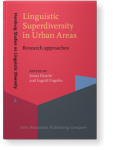Robert W. Schrauf
List of John Benjamins publications for which Robert W. Schrauf plays a role.
2023 Chapter 4. Mixed methods research on language learning in study abroad Methods in Study Abroad Research: Past, present, and future, Pérez-Vidal, Carmen and Cristina Sanz (eds.), pp. 85–106 | Chapter
Although research involving the theorized, principled, systematic integration of quantitative and qualitative approaches – mixed methods – is relatively rare in the literature on study abroad, there have been seminal, interesting, and impactful multiple methods contributions to this literature.… read more
2013 Using correspondence analysis to model immigrant multilingualism over time Linguistic Superdiversity in Urban Areas: Research approaches, Duarte, Joana and Ingrid Gogolin (eds.), pp. 27–44 | Article
The notion of immigrant and linguistic superdiversity privileges the multidimensional nature of multilingualism and requires analytic models that attend to the bidirectional interaction of many social and psychological variables. In this chapter I cast multilingualism as an interactive field of… read more
2011 The shifting structure of emotion semantics across immigrant generations: Effects of the second culture on the first language Modeling Bilingualism: From Structure to Chaos, Schmid, Monika S. and Wander Lowie (eds.), pp. 177–198 | Article
Cross-cultural evidence shows that the semantic domain of emotion words is organized along two dimensions: valence (pleasantness vs. unpleasantness) vs. arousal (low vs. high). However, collectivist cultures may bias their members to favor valence as valuable cues for interpreting social phenomena,… read more
2000 Narrative Repair of Threatened Identity Narrative Identity, Bamberg, Michael and Allyssa McCabe, pp. 127–145 | Article
In terms of positioning theory (Harré & van Langenhove, 1999), a person who has lost a contest may be said to have been forcibly positioned as a ‘loser.’ This threat to social identity requires some repair. Narrators may then tell stories in which they re-position themselves and other… read more



